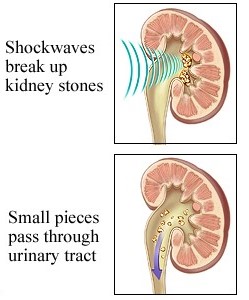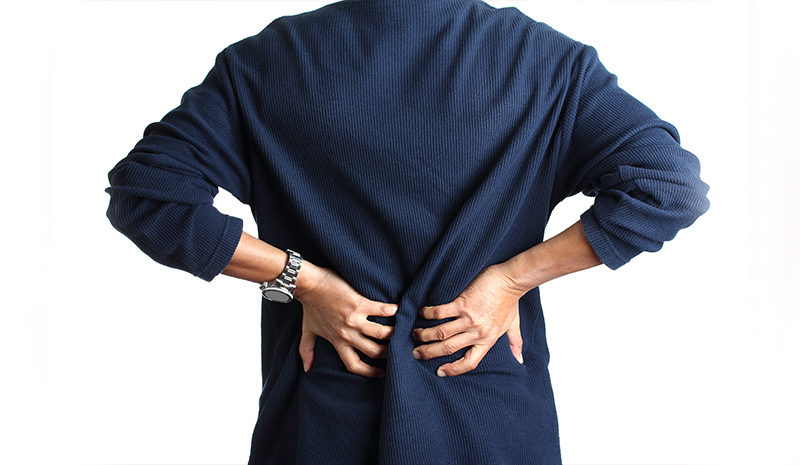What is ESWL?
ESWL is a method by which pressure waves that are generated outside the body, are passed into the body to break stones into small fragments, like grains of sand. It is a completely non-invasive form of treatment. Once this stone is broken up into such small fragments, they pass out in the urine stream over a period of time.
How is this treatment carried out?
The patient is first evaluated for the site, size, location, and a number of urinary stones. Other tests will also evaluate the function of the kidney so that, once the stone is powdered, the kidney must be able to push out the fragments. Tests are also done to evaluate other associated medical conditions if any, that may come in the way of utilizing this treatment. The patient is then placed on the table. A water balloon, inside which the pressure waves are generated, is placed in contact with the body on the side of the stone to be treated. Using x-ray imaging (fluoroscopy), the stone is localized and focused. Pressure waves are then generated and focused onto the stones approximately, one every second. These pressure waves will fragment the stone. The duration taken for this depends again on the size, location, and a number of stones to be treated. Generally, the duration is limited to 45 minutes.
What is the advice prior to each session of treatment?
You will be told to take 2 tablets of Dulcoflex the previous evening 7pm and to have regular dinner. On the day of the procedure, you can have light breakfast along with coffee/tea by 5.30 am and don’t take anything after that. You will have to be in the hospital by 8.30 am.
How many sessions are required?
Prior to every session, a repeat X-ray is taken to again localize the stone and check for bowel preparation. The fragmented stones will take time to pass down the urinary tract so a repeat treatment if required, will be administered after an interval of 10 days. The maximum number of sessions would be three. Even after this, if the stone does not break, alternative endoscopic procedures would be considered.
What are the advantages of ESWL?
The main advantage is that open surgery is not required. Apart from minimal discomfort, there is no severe pain and therefore the requirement of anesthesia is also very minimal. There is also no hospitalization involved most of the time; as a result, the patient can get back to work the next day.
Are there any complications of this procedure?
There are no known long term complications of this procedure. Side effects such as discomfort during the procedure may be present in a few occasions. Local redness over the abdomen or back may be present and this will disappear in few days. All patients will experience some amount of bleeding in the urine after treatment. Passage of the fragments down the urinary tube can cause pain, which can be managed by analgesics. Some patients however may need admission for cystoscopy and stenting of the ureter to prevent persistent pain. This may require hospitalization, for a day. At other times, a large load of stone powder may get blocked in the urinary tract again requiring admission and cystoscopic intervention. A small percentage (5%) of stones does not get broken by this method and may need other modes of stone removal.
Is success with ESWL 100%?
Definitely no. For stones 10mm to 20mm in the upper and middle part of the kidney, the success rate is around 75% and for stones in the lower part of the kidney, it is around 55%. For stones in the upper ureter, the success rate for less than 10mm stone is 90% and for more than 10mm stone it is between 60 and 70%. Certain specific stones like cystine and calcium oxalate monohydrate stones are resistant to ESWL. More than 2 cm renal stones are better treated with PCNL (Per-Cutaneous Nephro-Lithotomy).
Can you predict which stones fragment with ESWL?
Yes. Your doctor will study the IVU (Intra Venous Urography) to exactly know the size, location of the stone, anatomy, and function of the kidney before selecting this method of treatment. Your doctor will ask for CT Hounsfield unit of stone. If stones have more than 1000 HU, then chances of fragmentation by ESWL is less and your doctor will advise alternate forms of treatment.

After ESWL, do I need to come back for further evaluation?
Certainly. The proof of clearing the stone is ideally done by CT scan done 6 weeks later. But in clinical practice we do an ultrasound evaluation and X-ray KUB to confirm the clearance of the stones. Sometimes, small 3-4 mm stone fragment may be left behind, which generally are of no consequence.
Once this stone is treated, can I form a stone again?
Statistics indicate that 50% of all patients with urinary stones are likely to form a stone again. For this reason, certain dietary changes are prescribed to all patients. This mainly involves increased fluid/water intake, increased dietary fiber, cutting down on non-vegetarian food, and highly carbonated drinks. For this too, your urologist will give you details depending on the nature of the stone and associated medical conditions

